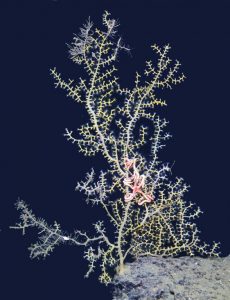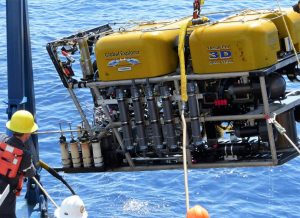Study Shows Oil Impacts in Deep-Sea Coral Colonies Seven Years After Deepwater Horizon
– NOVEMBER 27, 2018
Researchers analyzed high-definition imagery of over three hundred deep-sea coral colonies from 2011 – 2017 to quantify their recovery from the oil spill. The average overall visible effects from exposure to oil and dispersants on coral (such as covered in oil floc, excess mucus, bare skeleton, absence of polyps) decreased after 2011 and remained stable through 2017; however, after seven years the visible effects were still greater compared to reference sites. The initial level of impact had a significant effect on recovery between consecutive years and affected the proportion of healthy branches that remained healthy, unhealthy branches that recovered, and branches colonized by hydroids that recovered.
The researchers published their findings in Biological Conservation: Long-term impact of the Deepwater Horizon oil spill on deep-sea corals detected after seven years of monitoring.
“Deep-sea corals form oases of diversity in the deep Gulf of Mexico, and the thus the overall health of the Gulf depends in part on the health of coral ecosystems,” said study author Fanny Girard. However, the high longevity and low metabolic and growth rates of cold-water coral can increase their vulnerability to and slow recovery from environmental disturbances. After the Deepwater Horizon incident, there was concern about how this unprecedented disturbance would affect these corals.
This study’s researchers monitored 326 individual coral colonies in oiled and reference sites starting in 2011, when they coded branches as either healthy, unhealthy, colonized by hydroids, or unclassified (undetermined condition). The team imaged the same branches annually through 2017 to track changes over time and calculated the median level of total visible impact with and without including branch loss, which is an indicator of injury and compromised health. “The monitoring method we described in this study has many advantages, particularly that it is entirely based on images and thus allows the collection of data on individual corals without causing any damages,” said Girard.
Corals living in reference sites exhibited a low level of visible damage and low hydroid colonization. The health of most corals living in two of the oiled areas improved and had an average 6% increase in healthy branches per colony between 2011 and 2017. However, the health of corals living in the deepest oiled area deteriorated, with an average 3% decrease of healthy branches per colony over the study period. Corals at this particular site were smaller and branches were less dense than those at the other two sites. Overall, unhealthy branches were more likely to break than healthy branches, particularly when colonized by hydroids.
The researchers propose that the high branch loss observed on many impacted colonies combined with the coral’s slow growth rates may lead to a decrease in colony size and reproductive ability, which could have long-term consequences for the regional coral population. A model generated using the same study data (Girard et.al., 2018) estimated that spill-impacted corals may take up to three decades to recover and may experience a 10% reduction in biomass during that time.
“Our findings show that the majority of corals impacted by the Deepwater Horizon oil spill still had not recovered seven years after the spill, emphasizing the low recovery potential of these animals,” said Girard. “We focused on deep-sea corals, but the long-term impacts we detected likely had repercussions over the entire northern Gulf of Mexico. Our study suggests that preventing impact, by creating Marine Protected Areas for instance, is the best strategy.”
Data are publicly available through the Gulf of Mexico Research Initiative Information and Data Cooperative (GRIIDC) at doi:10.7266/N7CF9NH9, doi:10.7266/N7HQ3WVD, doi:10.7266/N7D21VJQ, doi:10.7266/N78913TC, and doi:10.7266/N74J0C2M.
The study’s authors are Fanny Girard and Charles R. Fisher.
By Nilde Maggie Dannreuther and Stephanie Ellis. Contact maggied@ngi.msstate.edu with questions or comments.
************
This research was made possible in part by a grant from the Gulf of Mexico Research Initiative (GoMRI) to the Ecosystem Impacts of Oil and Gas Inputs to the Gulf-2 (ECOGIG-2) consortium. Other funding sources included NOAA.
The Gulf of Mexico Research Initiative (GoMRI) is a 10-year independent research program established to study the effect, and the potential associated impact, of hydrocarbon releases on the environment and public health, as well as to develop improved spill mitigation, oil detection, characterization and remediation technologies. An independent and academic 20-member Research Board makes the funding and research direction decisions to ensure the intellectual quality, effectiveness and academic independence of the GoMRI research. All research data, findings and publications will be made publicly available. The program was established through a $500 million financial commitment from BP. For more information, visit https://gulfresearchinitiative.org/.
© Copyright 2010-2018 Gulf of Mexico Research Initiative (GoMRI) – All Rights Reserved. Redistribution is encouraged with acknowledgement to the Gulf of Mexico Research Initiative (GoMRI). Please credit images and/or videos as done in each article. Questions? Contact web-content editor Nilde “Maggie” Dannreuther, Northern Gulf Institute, Mississippi State University (maggied@ngi.msstate.edu).







